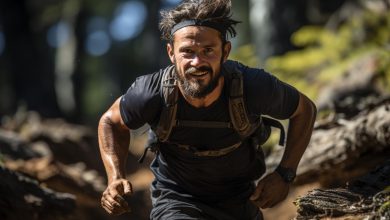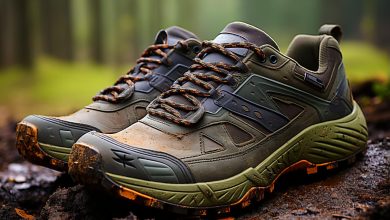Trail Running Recovery: Techniques for Rest and Rehabilitation

Are you looking for ways to enhance your trail running recovery? Look no further! In this article, we will explore effective techniques and practices to help you rest and rehabilitate after those intense trail runs.
By understanding the importance of rest, incorporating active recovery exercises, and focusing on proper nutrition, you can speed up your recovery time and get back on the trails stronger than ever.
So let’s dive in and discover how to optimize your trail running recovery journey.
Understanding the Importance of Rest in Trail Running Recovery

You need to understand the importance of rest in trail running recovery and make it a priority. Rest is an essential component of any training program, but it becomes even more crucial when you engage in trail running. The uneven terrain, constant elevation changes, and technical challenges put additional stress on your body. Rest and recovery strategies play a vital role in preventing injuries and optimizing performance.
One of the most important aspects of rest in trail running recovery is getting enough sleep. Sleep is when your body repairs itself, both physically and mentally. During deep sleep, your muscles recover from the micro-tears that occur during exercise, allowing them to grow stronger. Additionally, sleep plays a critical role in memory consolidation and cognitive function, helping you stay focused and alert on the trails.
Research has shown that inadequate sleep not only impairs physical performance but also increases the risk of injury. Lack of sleep can lead to decreased reaction time, impaired decision-making skills, and compromised immune function. It’s recommended to aim for 7-9 hours of quality sleep per night to optimize trail running recovery.
Transitioning into effective techniques for active recovery in trail running…
Effective Techniques for Active Recovery in Trail Running

One effective way to actively recover from trail running is by incorporating low-impact activities like swimming or cycling into your routine. Active recovery has numerous benefits for trail runners, including improving blood flow and reducing muscle soreness. By engaging in these low-impact exercises, you can promote the healing process and enhance your overall performance.
Swimming is an excellent choice for active recovery because it provides a full-body workout without putting excessive strain on your muscles and joints. The water’s buoyancy reduces the impact on your body while allowing you to engage in cardiovascular exercise. Cycling is another great option that allows you to work different muscle groups while minimizing stress on your joints.
In addition to incorporating low-impact activities, post-run stretching techniques are crucial for active recovery. Stretching helps reduce muscle tightness and improves flexibility, which can prevent injuries and promote faster recovery. Dynamic stretches, such as leg swings and hip circles, are particularly beneficial for trail runners as they mimic the movements involved in running.
Rehabilitation Exercises for Injured Trail Runners

Incorporating specific exercises into your routine can help injured trail runners rehabilitate and regain strength. When recovering from an injury, it’s important to focus on exercises that target the affected area while also improving overall fitness. Here are four rehabilitation exercises specifically designed for injured trail runners:
1. Clamshells: Lie on your side with knees bent and feet together. Slowly lift the top knee while keeping your feet together, then lower it back down. This exercise strengthens the hips and glutes, which are crucial for stability during trail running.
2. Single-leg squats: Stand on one leg with the other leg extended in front of you. Slowly bend the standing knee, lowering yourself into a squat position, then return to standing. This exercise improves balance and strengthens the quadriceps.
3. Calf raises: Stand with your feet shoulder-width apart and rise up onto your toes as high as possible, then lower back down. This exercise targets the calf muscles, which play a key role in trail running.
4. Plank variations: Perform plank exercises such as forearm planks or side planks to strengthen your core muscles, which provide stability during trail running.
Remember to consult with a healthcare professional before starting any new exercise program, especially if you’re recovering from an injury. These rehabilitation exercises can aid in your recovery journey and get you back on those trails stronger than ever before!
The Role of Nutrition in Trail Running Recovery

When recovering from an injury, it’s essential to focus on proper nutrition for optimal trail running recovery. Nutrition plays a crucial role in repairing tissues and reducing inflammation, allowing your body to heal faster and get back on the trail sooner.
To support your recovery, make sure you’re consuming a balanced diet that includes all the necessary nutrients.
First and foremost, prioritize protein intake. Protein is essential for muscle repair and growth. Include lean sources like chicken, fish, tofu, or beans in each of your meals. Additionally, carbohydrates are important for replenishing glycogen stores and providing energy during exercise. Choose complex carbs such as whole grains, fruits, and vegetables.
Hydration is another key element of recovery nutrition. Water helps transport nutrients to cells and flush out toxins from the body. Aim to drink at least 8-10 cups of water per day or more if you’re engaging in intense physical activity.
Incorporating anti-inflammatory foods can also aid in recovery. Foods rich in omega-3 fatty acids like salmon, walnuts, or chia seeds can help reduce inflammation and promote healing.
Remember that proper nutrition is just as important during rest days as it is during training days. By fueling your body with the right nutrients and staying hydrated, you’ll optimize your trail running recovery and be back on the trails stronger than ever before.
Restorative Practices to Enhance Trail Running Performance

To enhance your trail running performance, it’s important to prioritize restorative practices that allow your body to recover and prepare for future runs. Here are four key techniques that can help you achieve this:
1. Stretching exercises: Stretching before and after your trail runs can increase flexibility, improve range of motion, and prevent injuries. Focus on stretches that target the major muscle groups used in running, such as the hamstrings, calves, quadriceps, and hip flexors.
2. Foam rolling techniques: Foam rolling is a self-massage technique that uses a foam roller to release tension in muscles and fascia. By applying pressure along different areas of your body, you can reduce muscle soreness and tightness. Spend time targeting areas like the IT band, glutes, and calves.
3. Active recovery: Engaging in low-impact activities on rest days can promote blood flow to your muscles without putting additional stress on them. Activities like walking or cycling can help flush out metabolic waste products and aid in muscle repair.
4. Quality sleep: Getting enough sleep is crucial for optimal recovery. During sleep, your body repairs damaged tissues and releases growth hormones necessary for muscle development. Aim for 7-9 hours of uninterrupted sleep each night to support your trail running performance.
Conclusion
In conclusion, rest and recovery are vital components of trail running. By incorporating effective techniques for active recovery, such as foam rolling and stretching, you can enhance your overall performance.
Additionally, rehabilitation exercises play a crucial role in helping injured trail runners recover and get back on the trails. Remember to fuel your body with proper nutrition to support your recovery process.
Interestingly, studies have shown that taking just one day off from training per week can reduce the risk of injury by 70%. So prioritize rest, take care of your body, and enjoy the benefits of a well-rounded trail running routine.






